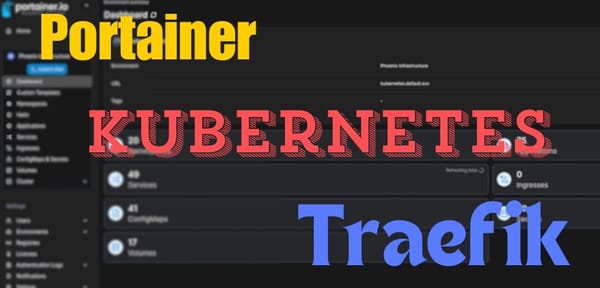How To Install Traefik Ingress Controller In Kubernetes
Use Traefik Ingress Controller as Proxy in Kubernetes (k8s) to provide load balancing, name-based virtual hosting, and SSL termination
Introduction
This tutorial will show how to use Traefik as an Ingress Controller in Kubernetes (or k8s) to provide load balancing, name-based virtual hosting, and SSL termination.
To follow this tutorial you need:
- A running Kubernetes cluster or a Managed Kubernetes
- A Load Balancer that dynamically distributes your traffic to any Kubernetes resource that is marked as LoadBalancer
- A PRIMARY_DOMAIN
PRIMARY_DOMAIN, please change accordingly. If your desired domain is paulsblog.dev, replace PRIMARY_DOMAIN with paulsblog.dev.What is an Ingress Controller?
An Ingress Controller is an API object that will manage external access to any deployed service in a Kubernetes cluster. Typically HTTP or HTTPS is used. Furthermore, it provides load balancing, name-based virtual hosting, and SSL termination.
Why do you need an Ingress Controller?
This list will show the most important benefits of using an Ingress Controller in a Kubernetes cluster:
- Load balance any traffic between every service that is deployed outside of the Kubernetes cluster
- Allow HTTP traffic between services within the cluster but enforce HTTPS traffic from outside the Kubernetes cluster while terminating encryption.
- Simplify interaction between internal services and re-route when required by changing the Ingress Routing Rule.
Prepare Kubernetes Environment
Installing Helm, Kubernetes Package Manager
To install Helm on your Kubernetes cluster you can use the official Helm installer script that will automatically install the latest version.
Before installing Helm, you can get a deeper understanding of Helm if you read about it in the official Helm documentation. Afterward, download the script and execute it locally.
curl -fsSL -o get_helm.sh https://raw.githubusercontent.com/helm/helm/main/scripts/get-helm-3
chmod 700 get_helm.sh
./get_helm.shConfigure kubectl To Access The Kubernetes Cluster
If kubectl is used you can use three different techniques to work with the cluster:
1. Use --kubeconfig flag for every command:
kubectl get pods --kubeconfig=config1
kubectl get pods --kubeconfig=config2
2. Use KUBECONFIG environment variable:
export KUBECONFIG=config1
kubectl get pods
kubectl get all
export KUBECONFIG=config2
kubectl get pods
kubectl get all3. Copy the config file to $HOME/.kube/config
Prepare Helm Chart
To install Traefik you have to add the official Traefik Helm repository to your Helm client. This could be done by executing:
helm repo add traefik https://helm.traefik.io/traefik
helm repo updateAfterward, you have to configure the Helm chart by creating a values.yaml. All possible values can be found in the GitHub of the Traefik Helm chart and will be used to set the static configuration of the Traefik proxy.
Now, you should create a values.yaml and paste the following into it:
---
additionalArguments:
- --entrypoints.websecure.http.tls.certresolver=ionos
- --entrypoints.websecure.http.tls.domains[0].main=PRIMARY_DOMAIN
- --entrypoints.websecure.http.tls.domains[0].sans=*.PRIMARY_DOMAIN
- --certificatesresolvers.ionos.acme.dnschallenge.provider=ionos
- --certificatesresolvers.ionos.acme.email=webmaster@PRIMARY_DOMAIN
- --certificatesresolvers.ionos.acme.dnschallenge.resolvers=1.1.1.1
- --certificatesresolvers.ionos.acme.storage=/data/acme.json
deployment:
initContainers:
- name: volume-permissions
image: busybox:1.31.1
command: ["sh", "-c", "chmod -Rv 600 /data/*"]
volumeMounts:
- name: data
mountPath: /data
env:
- name: IONOS_API_KEY
valueFrom:
secretKeyRef:
key: IONOS_API_KEY
name: ionos-api-credentials
ingressRoute:
dashboard:
enabled: false
persistence:
enabled: true
path: /data
size: 128MiThis values.yaml is used to configure the Traefik proxy and will:
- use IONOS as the certificate resolver. To find your provider consult the traefik documention
- set the certificates main domain to
PRIMARY_DOMAIN - set the certificates sans to
*.PRIMARY_DOMAIN - store every generated certificate in
/data/acme.json - run a busybox init container to fix a common permission problem that is explained here: https://github.com/containous/traefik/issues/6972
- load the IONOS_API_KEY from a secret. If using some other provider add every needed environment variable
- deactivate the Traefik dashboard
- enable persistence for the Traefik proxy
Install Traefik Proxy As Ingress Controller
To install Traefik Proxy in your Kubernetes cluster follow the next 4 simple steps
1. Begin with creating a Kubernetes namespace:
kubectl create namespace traefik2. Create a treafik-secret.yaml that will contain the secret used within the Helm chart for SSL certificate creation:
---
apiVersion: v1
kind: Secret
metadata:
name: ionos-api-credentials
namespace: traefik
type: Opaque
stringData:
IONOS_API_KEY: asdkjalshdasdlasdasd.asdahsdhasdkjahsdkasgdkasdg;aksda;d
3. Apply the secret in your Kubernetes cluster:
kubectl apply -f traefik-secret.yaml4. Install Traefik using Helm and apply values.yaml
helm install traefik traefik/traefik --namespace=traefik --values=values.yamlIf you change anything within the values.yaml and want to update the Traefik proxy this can be done by executing:
helm upgrade traefik traefik/traefik --namespace=traefik --values=values.yamlSome minutes later your Traefik is deployed correctly and you can map your PRIMARY_DOMAIN A record to the IP of the Traefik Load Balancer. You can find the external IP by executing:
kubectl get all -n traefikIt should output the following:

If the external IP is not set wait some time and retry it. If you did not receive an external IP you probably did not have an external load balancer installed/bought.
Enable Traefik Dashboard
To enable the Traefik Dashboard within the Kubernetes cluster you will have to create an Ingress route and a middleware to enable Basic authentication.
Create a new folder called traefik-dashboard which will contain every file to set up the Traefik dashboard.
Now, create a base64 encoded user and password that will be used within the Kubernetes secret:
htpasswd -nb superTraefikUser unbelievableSafePassword | openssl base64Afterward, copy the htpasswd string and create the Kubernetes secret 001-auth-secret
---
apiVersion: v1
kind: Secret
metadata:
name: traefik-dashboard-auth
namespace: traefik
data:
users: YOUR_UNBELIEVABLE_SECURE_HTPASSWD_STRING
Then create a Kubernetes middleware 002-middleware that will use the basic auth secret:
apiVersion: traefik.containo.us/v1alpha1
kind: Middleware
metadata:
name: traefik-dashboard-basicauth
namespace: traefik
spec:
basicAuth:
secret: traefik-dashboard-authNow you can create the Ingress route 003-ingressroute for the Traefik dashboard:
---
apiVersion: traefik.containo.us/v1alpha1
kind: IngressRoute
metadata:
name: traefik-dashboard
namespace: traefik
spec:
entryPoints:
- websecure
routes:
- match: Host(`traefik.PRIMARY_DOMAIN`)
kind: Rule
middlewares:
- name: traefik-dashboard-basicauth
namespace: traefik
services:
- name: api@internal
kind: TraefikServiceIf you named the files as described you should have the following file structure:
traefik-dashboard
--001-auth-secret
--002-middleware
--003-ingressrouteSwitch to the upper folder and use the following command to apply all files in the correct order:
kubectl apply -f traefik-dashboardClosing Notes
I hope this article gave you a quick and neat overview of how to set up Traefik Proxy as an Ingress Controller within your Kubernetes cluster.
Using Helm to set up a Traefik Ingress controller makes it really easy to install, reconfigure, and update the Traefik Proxy.
I would love to hear your feedback about this tutorial. Furthermore, if you already run a Traefik installation and use a different approach please comment here and explain what you have done differently. Also, if you have any questions, please ask them in the comments. I try to answer them if possible.
Feel free to connect with me on Medium, LinkedIn, Twitter, and GitHub.
🙌 Support this content
If you like this content, please consider supporting me. You can share it on social media, buy me a coffee, or become a paid member. Any support helps.
See the contribute page for all (free or paid) ways to say thank you!
Thanks! 🥰



